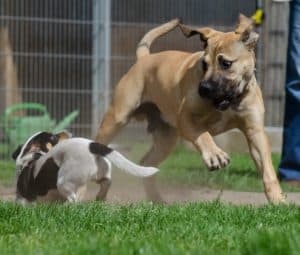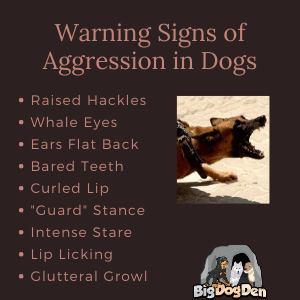There are certainly some contradictions in opinion when it comes to why small dogs bark at big dogs out there. It can be overwhelming! If you’d rather glean from the latest and most accurate information, all gathered in one convenient place, you’ve landed on the right site. Welcome to the Big Dog Den, I’m glad you’re here!
Today you’ll discover:
- What Small (or Little) Dog Syndrom Is (and Isn’t)
- Why it’s Important to Adress Your Little Dog’s Behavior
- How Socializing Your Dog Can Help
- Training Techniques to Silence a Small Dog
- The Importance of Praise (and Treats!)
- How Small Dogs and Big Dogs can Live in Harmony
And so much more!
I’ve saved you the time and headache of separating fact from myth when it comes to training your dog to exhibit new behaviors. I’ve owned dogs from my youth and learned much from personal experience and even more from my dogs’ veterinarian. I didn’t stop there though! For this article, I’ve also gleaned information from experts like the American Kennel Club, the Merck Veterinary Manual, Purina.com, Pet Care Rx, Cesar Milan, and more! Additionally, are interviews with dozens of people who own both a small dog and a big dog to learn some “hands-on” tips for helping dogs get along.
There’s a lot of information to sort through to dig out the facts, so let’s get started!
Do Small Dogs Really Bark More Than Big Dogs?

In a word, absolutely! In general. Like humans, each dog is unique with his (or her) very own traits, personality, and quirks. Some of this barking can be attributed to breed or size, and some of it attributed to nervousness and/or excitement.
It won’t take a dog owner long to recognize that their dog will have a “different” bark for different circumstances. Observing your dog from the day he (or she) arrives at your home will be your greatest insight into any behaviors exhibited. Listen to the different barks to learn what they mean. My dog has a “hungry” bark, a bark for when friends approach, and a very different bark when strangers approach! It’s important we remember that we aren’t trying to stop a small dog (or any dog) from barking altogether. We’re only addressing the nuisance barking and the inappropriate barking.
Watch the dog’s body language, as well. This is how dogs communicate with each other, and how your own dog “reads” you. Your dog’s body language changes when he (or she) is feeling nervous, fearful, or even aggressive.
The next time your little dog goes into a yapping frenzy, watch that body! The barking may be more than simple vocalization if it is accompanied by one (or more) of the following 10 “Body Languages” of Aggression:
- Raised Hackles (hair along the neck/back)
- Excessive Panting or Lip Licking
- Stiff Posture
- Whale Eyes
- An Intense Stare
- Ears That are Laid Flat Back (or Standing Straight Up Stiffly)
- Bared Teeth
- Curled Lip
- A “Guard Stance” Head Lower than Shoulders
- A Glutteral Growl
If any of those signs are visible in your dog’s body language during a “bark fest”, you are dealing with aggression and not just an overly-vocal dog. If this is the case, barking can be a precursor to undesirable behaviors like lunging and/or biting. You’ll have to approach the issue from an aggression standpoint, not a nuisance barking standpoint.
DID YOU KNOW? The Chihuahua dog breed barks the most of any breed.
Is “Small Dog Syndrome” Real?

“Small (or Little) Dog Syndrome” is defined by Purina.com as “…the name that’s given to a collection of behaviors displayed by small dogs, behaviors that have the effect of overcoming any deficits caused by being small in stature.” Pet Care Rx adds some insight by reporting that excessive barking in small dogs when they encounter bigger dogs, is a learned behavior that can be adjusted through training and socializing the small dog from a young age.
If you know (or own) a small dog who exhibits some of the following behaviors, he (or she) may have what’s been coined “Small Dog Syndrome:
- Over-Excitement
- Jumping on Human, or Other Animals
- Growling on Introductions
- Lunging or Snapping at Perceived Threats
- Fear of Other Dogs
- Disobedience to Your Commands
Of course, not all small dogs will exhibit these behaviors and not all dogs that exhibit these behaviors are small. Generally, the younger the dog when training and adequate socialization occur, the less yappy the dog will be in his (or her) adulthood and the less likely they will suffer from any behavioral syndromes in adulthood.
DID YOU KNOW? Dogs can tell how big another dog is by the other dog’s bark?
How to Use Socialization to Minimize Barking

Socialization is exactly what it sounds like. From the time your dog arrives at your home, you should make it a point to introduce him (or her) to as many other humans, animals, and situations as possible. Begin gradually, and have all safety equipment in place. This equipment is, of course, a leash, collar and/or harness. Additionally, even a small dog should wear a muzzle when being introduced to new people, animals, or situations.
Why muzzle a small dog? It’s a no-brainer to muzzle a large breed dog because their bite can be fatal. Furthermore, a muzzle on a big dog may make the humans around him (or her) feel more comfortable. But surely, a small dog can do no harm, right? Wrong! A dog bite is a dog bite and it hurts! Additionally, once your dog does any harm to a human or another animal, he (or she) may be added to a “mean dog” list in your community, and have restrictions placed upon him.
You’ll want to begin socializing your dog when he (or she) has mastered the 5 Basic Commands. These are: Come, Heel, Sit, Down, and Stay. The more your dog understands what you expect of him (or her) the easier it will be for you to make effective introductions between your dog and other animals (or humans).
With safety measures in place like the ones we just went over, it’s time to start socializing your dog!
5 Steps to Follow When Introducing Your Dog to Another Dog:
- Have your dog muzzled and on a leash at your side. (If the small dog doesn’t bark, or stops barking on command, reward him (or her) with praises or treats.
- Approach the other dog slowly or wait patiently as another dog approaches yours. (If the small dog is still barking when the dogs are face to face, and won’t quiet down on command, remove him (or her) from the scene and try again another time. Punishment is ineffective, as it’s sure to confuse an already-agitated dog.)
- Speak to both dogs in a calm and reassuring voice.
- If no signs of aggression have been displayed by either dog, while your dog is still on his leash, let him (or her) and the other dog sniff at each other generously. (And be glad that’s not how humans get acquainted, LOL!)
- Once the animals exhibit a relaxed body posture reward them with rewards of praise and/or treats, and let them have some playtime together.
Please Note: Regardless of your dog’s size, he (or she) should never be left with small children unattended.
Can a Small Dog be Taught Not to Bark at Big Dogs?

Yes, yes, and YES! By the time you finish this article, you’ll be “armed” with effective techniques for training your dog to get quiet on command. All training should begin as early as possible in the dog’s life, all training takes time, and all training is ongoing throughout your dog’s life.
Should You Use a “Bark Collar”?
I have the utmost respect for the American Society for the Prevention of Cruelty to Animals (ASPCA). Although their opinion is sometimes contrary to popular opinion, the safety and well-being of all animals is their primary concern, and we ought to carefully consider their advice. On the subject of training that utilizes a bark collar, this is their stance:
“The ASPCA supports training methods that are based on an understanding of how animals learn and incorporate kindness and respect for both the pet and the guardian. Humane training does not inflict unnecessary distress or discomfort on the pet. Humane training makes primary use of lures and rewards such as food, praise, petting, and play. In addition to lures and rewards, there are many training tools and types of equipment designed to assist guardians in managing their pets’ behavior at home and in public places. The ASPCA supports the use of methods and equipment that effectively accomplish the training objective with the least amount of stress for the pet. The ASPCA is opposed to any training equipment that causes a pet to experience physical discomfort or undue anxiety.”
That being said, I also understand that there are certain dogs who will never respond to traditional training methods and will bark to the point of being a nuisance. In extreme instances, your dog’s veterinarian may recommend using a bark collar. I would add that a bark collar should only be used during times when barking is inappropriately excessive. The collar shouldn’t be on your dog 24/7.
Before deciding on a bark collar, do your research. Consider the veterinarian’s advice and see if it’s alignment with what your research reveals. Lastly, the best way for you to fully understand the bark collar’s effects will be to experience them for yourself. Test every level option the collar features on one of your arms or legs. If you experience any kind of pain, do not place the collar on your dog!
Once you experience the different options on the collar, select the power option right for your dog’s size and tolerance and follow instructions precisely.
Ultimately, when all the research has been done and all advice heard, whether you opt for using a bark collar or not is completely up to you!
DID YOU KNOW? Shock Collars were introduced in the 1960s. Proponents call them effective training tools and those opposed to the collars call them cruel. Today, shock collars are banned in many countries.
Dog Training Tips for Excessive Barkers

We talked about the 5 Basic Commands earlier in the “How to Use Socialization to Minimize Barking” section. Training your dog to be silent on command can be incorporated right into the basics! All commands you teach your dog should be a word (the shorter the command, the easier for the dog to understand) used in combination with a hand gesture. All humans who interact with the dog should be consistent in word and gesture.
If you own a small breed known to be excessive barkers, create a command and gesture to use when you want the barking to stop. I hold my hand up like I’m stopping traffic and issue the command word “Quiet!” You use which word and gesture are appropriate for you. A lot of dog owners I know simply use “Shhhh!”.
Incorporate the command when teaching your dog(s) the basic 5. A great opportunity to practice the command is when your doorbell rings and sends your dog into a yapping frenzy. Acknowledge that the dog is a good boy (or girl) to notify you there’s someone at the door, and then give your command for “quiet” (whatever it is). If the dog’s barking doesn’t cease, remove him (or her) from the room and ignore the barking coming from behind the closed door.
Please remember that punishment is not an effective training technique.
When the dog quiets down reward him (or her) and allow re-entry to the room. One dog owner I interviewed practiced the doorbell challenge by enlisting the help of her friend. The friend rang the doorbell, the dog barked excessively (as usual) and wouldn’t stop. The owner then employed the method we just discussed and, with her friend’s help, repeated the procedure until the dog quieted on command, and the owner was able to open the door and greet her friend without having to raise her voice above the level of a barking dog.
It took about a dozen tries. That’s the patience I’ve mentioned a couple of times in this article. Your dog learns through repetition, so consistency is key. So many dog owners engage in a vocal battle with a barking dog without realizing the dog can mistake your tirade of words as having all your attention for him (or her) which is your dog’s delight. Removing the dog from the situation in which the excessive barking occurs takes your attention off the dog, which he (or she) dislikes.
It won’t take long for your dog to learn the best way to get your attention is through quiet and calm behaviors at certain times. This is why the reward of praise or treats is an effective training method. “Catch” your dog being good, and reward that good behavior! When I can visibly see my dog restraining himself from barking in places he was once prone to barking excessively, I reward the effort he is displaying by with-holding the bark. I make a big deal of it, and he lights up like a Christmas tree… he knows he’s pleased me, and it delights him!
Don’t give up on training your dog! He (or she) will come to understand (depending on breed) from 150-250 words by adulthood. Your dog is smarter than you think and pleasing you is what drives him (or her). Exhibit your pleasure through words and body language and exhibit your displeasure by removing your dog from a situation in which he’s misbehaving. His (or her) absence from you will speak louder than your words.
Just a little off-subject tip for you here, since we’re discussing eliminating bad behaviors in dogs. To discourage a dog from jumping on you, turn your body away from him (or her) each time the dog begins to jump. Again, the dog wants to engage with you more than anything. Your body language in turning away teaches the dog that jumping will not get your attention. Again, this technique takes time, consistency, and dedication.
DID YOU KNOW? Since dogs rely so heavily on body language for communication, dressing them in canine clothing for a trip to the dog park can interfere with effective communication between dogs.
Something to Consider About Barking Dogs
When training a dog not to bark, please remember that dogs do not speak. They bark. Your dog needs some time to bark gleefully, to bark as a warning and to bark simply to… well… bark. Just like a child is taught to sit quietly thorough class but is permitted to squeal with delight in the play yard, so it is with a dog barking. Your dog can learn there are times to be silent, and times to bark. It’s on you to set the boundaries and make sure there’s a balance within them.
What Makes a Happy (and Quiet) Dog?

Your dog’s overall well-being comes from a variety of combined components. These components come together in the form of a dog who is friendly and energetic, who obeys commands, and who is a faithful and loyal companion. Put emphasis on each of the following components to guide your dog through a happy and long life:
Bonding: The time you spend bonding with your dog is as enjoyable and beneficial to you as it is to the dog. Every interaction you have with your dog is an opportunity to strengthen that bond. The bond is reinforced through affection and time spent together. Bonding with your dog is an on-going and lifetime venture, and one of the sweetest bonds you will have in your life.
Health: Healthier dogs will live longer lives, and we all want that for our beloved companions, don’t we? Above a long life, though, it’s also important our furry buddies live the highest-quality life possible! This comes from the dog having adequate healthcare. This includes having high-quality nutrition and regular examinations from the veterinarian.
Exercise: Not only does your dog’s physical health benefit from having sufficient exercise so does his mental health! Exercise strengthens your dog’s muscles, joints, and endurance levels. It also stimulates his (or her) mind, staves off boredom, and provides a healthy way to burn off energy that when pent up can promote disruptive or even destructive behaviors. For this reason, be sure your dog is getting the exercise he needs according to breed, age, and any health or fitness issues. Walks will provide most of the exercise a dog needs, but ideally, you should be adding other activities to the exercise agenda that challenge your dog and provide tons of fun at the same time!

Training: We’ve talked a lot about training techniques here today, and we well should! An adult dog’s behaviors are the direct result of the training he (or she) received (or didn’t receive). Start training your dog(s) early and never stop!
Socialization: The dogs with the friendliest personalities are the ones who were given ample opportunities throughout their lives to meet as many new people and animals as possible. Repetition is how dogs become familiar with the unfamiliar, so repeatedly expose him (or her) to new people, animals, and places.
When you devote your time and attention to making sure these components are present and thriving in your dog’s life, you will have a healthy and well-rounded adult dog, likely to live well into his (or her) senior years!
DID YOU KNOW? Generally, small-breed dogs have longer lifespans than large-breed dogs.
Can Small Dogs & Big Dogs Live Together?
In almost every circumstance, small dogs and big dogs can live together in peace. The exception to this is when one of the two dogs is facing extenuating circumstances. A dog that’s been rescued from a dog-fighting ring or from a puppy mill, for example, may face additional issues in proper socialization etiquette. And take heart! Even dogs who’ve come from the worst of circumstances can usually be rehabilitated with kindness, patience, training, and time.
Generally speaking, dogs of any size or breed can live together. You’ll want to introduce the dogs using the technique we discovered in the 5 Steps (when making dog introductions) section above. Remember that your body language and approach when making introductions is important, as well as ensuring both dogs’ safety.
When bringing a new dog into your home that already houses another dog, the size of either dog is pretty much irrelevant, unless either dog is showing signs of aggression.

5 Tips for a Two-Dog (or more) Household
- Make introductions fun and pleasant. If one dog isn’t “feeling it” separate the two and try again later. Never force the issue, give them time to get used to each other.
- Do not leave the dogs together unattended until you are positive they have found a comfortable coexistence.
- Experiment to find a feeding method that works best for you and your dogs. In the case of feeding a big dog and a small dog, they should be eating different foods from different bowls, since the nutritional need varies so greatly between small dogs and big dogs. *To learn more about which dog food which dog should be eating, please read “Small, Medium and Large Breed Dog Food: What’s the Difference?” right here in the Big Dog Den.
- Your dogs will likely compete for your attention. Although it’s fun to play with both dogs together, it’s also important that you have one-on-one time with each dog. Good times to ensure each dog gets the individual attention he (or she) needs are during training time, grooming time, walk time, and playtime. Each dog is unique and the bond you share with each is unique.
- Remember that tired dogs are happy dogs. When a dog isn’t getting the opportunity to release his (or her) pent-up energy, that energy can manifest as nervousness, irritability, and even aggression. Make sure your small dog and big dog are getting the exercise they need every day. This is another area where their needs differ, so make sure each need is being met.
DID YOU KNOW? When you bring a big-breed dog into a household where a small-breed dog currently reigns, the smaller dog will naturally take on the “alpha” role and the bigger dog will respect the hierarchy. I just think it’s adorable to watch a tiny alpha reign over a dog three (or more!) times his (or her) size, and had to share 🙂

Did you discover anything that surprised you today? I sure did! There are so many ways we can encourage our dogs to exhibit the behaviors we desire and to have an allover well-rounded personality. At the end of the day, the more we’ve worked with our beloved four-legged companions, the more enjoyable our time with them becomes. Thank you for dropping by the Big Dog Den, I hope to “see” you here again soon!
*This article has been reviewed in accordance with our editorial policy.

